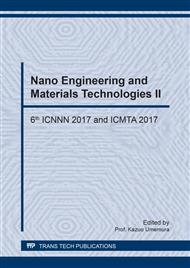p.96
p.101
p.107
p.115
p.120
p.125
p.130
p.134
p.139
Adsorption of Methylene Blue (MB) Dye in Wastewater by Electrospun Polysulfone (PSF)/Organo-Montmorillonite (O-MMT) Nanostructured Membrane
Abstract:
In this study, organo-montmorillonite was utilized as an additive for the fabrication of the nanostructured membrane via electrospinning process.The purpose of this study is to investigate the performance of 95% PSF and 5% O-MMT blend in terms of its adsorption capacity towards MB dye in wastewater and comparing it to pure PSF membranes. Pure PSF and 5% O-MMT blend were immersed in the simulated wastewater at different time intervals (1, 5, 12, 24 and 48 hours), and the change in MB dye concentration was observed by UV-Vis absorbance reading. To determine the mechanism of adsorption, the data obtained were subjected to pseudo-first order and pseudo-second order kinetic models, and were fitted to Langmuir, Freundlich and Temkin adsorption isotherms to determine the adsorption equilibrium data. The results show that the adsorption efficiency was improved by 5.32%.
Info:
Periodical:
Pages:
120-124
Citation:
Online since:
March 2018
Price:
Сopyright:
© 2018 Trans Tech Publications Ltd. All Rights Reserved
Share:
Citation:


